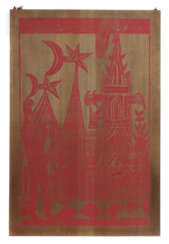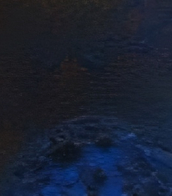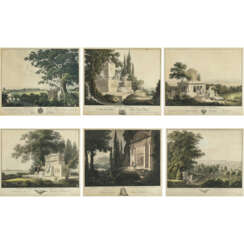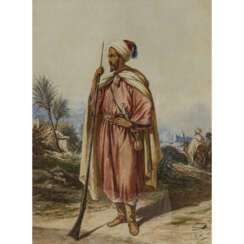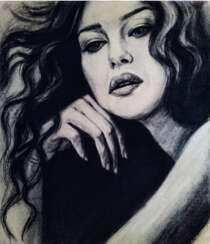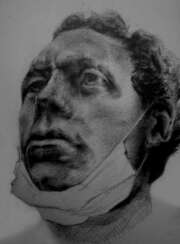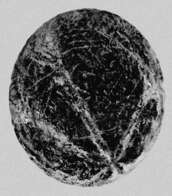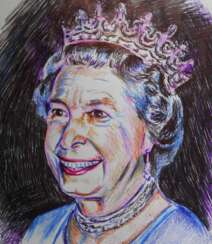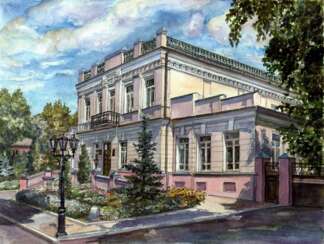14 Items by auctions and galleries:
grafiken des 20. jahrhunderts
Paintings by Denis Veles
Denis Veles (b. 1984)  Shop Veles Denis
Shop Veles Denis

Denis Veles
30.12.1984
Russia
Велес Денис Сварожич – художник-график, родился и проживает в Москве. Из дворянского польского рода Лис-Олтаржевских. Внук заслуженного художника РСФСР.
В 2008 году окончил МГХПУ им. Строганова Кафедры «Искусства графики». Имеет медаль «За заслуги в культуре и искусстве». Художник с институциональным признанием.
Одну из его картин «Крымский мост», станковая графика, можно увидеть в информационных изданиях об академии на английском языке «МГХПА 2021 проспект» и к 190 лет МГХПА им. С.Г. Строганова.
С 2004 года Денис Велес участвует в благотворительных выставках и фестивалях в Москве. Акварель Дениса Велеса была признана национальным наследием как институциональное достояние королевства Испании.
Paintings by Denis Veles Russian artist graphics.Graphics. Watercolour. Moscow Union of Artists. Masterpiece. Gallery. Collection.
Lukisan oleh Denis Veles seniman Rusia grafis.Grafis. Cat air. Persatuan Seniman Moskow. Mahakarya. Galeri. Koleksi.
Pinturas de Denis Veles artista ruso graphics.Graphics. Acuarela. Unión de Artistas de Moscú. Obra maestra. Galería. Colección.
Dipinti di Denis Veles artista russo grafica.Grafica. Acquerello. Unione degli artisti di Mosca. Capolavoro. Galleria. Collezione.
Denis Veles 的画作 俄罗斯艺术家图画。水彩画。莫斯科艺术家联盟。杰作。画廊。收藏。
Gemälde von Denis Veles Russischer Künstler Graphik.Graphik. Aquarell. Moskauer Union der Künstler. Meisterwerk. Galerie. Sammlung.
Pinturas de Denis Veles Gráficos de artistas russos.Gráficos. Aguarela. União dos Artistas de Moscovo. Obra-prima. Galeria. Coleção.
Peintures de Denis Veles Artiste graphique russe.Graphiques. Aquarelle. Union des artistes de Moscou. Chef-d'œuvre. Galerie. Collection.
Denis Velesによる絵画 ロシア人アーティスト graphics.グラフィック. 水彩画。モスクワ芸術家連合。傑作. ギャラリー. コレクション。
لوحات للرسام دينيس فيليس، فنان جرافيك روسي. ألوان مائية. اتحاد موسكو للفنانين. تحفة. صالة عرض. مجموعة.

Artist shop
Veles Denis
Russia
Number of products: 37
Portrait of Monica Bellucci
Julia Lihina (b. 1984)  Shop Lihina Julia
Shop Lihina Julia

Julia Lihina
10.11.1984
Ukraine
Я, Юлия Лихина, родилась в Харькове, Первой столице Украины, 10 ноября 1984 года. Была очень непоседным и упертым ребенком, постоянно меня носило где-то. Мама смотрела на меня, и хоть как ни будь меня угомонить, показала и научила рисовать в 3 года. Мои первые полотна - это стены, полы и мебель в доме. Потом изостудия в 5 лет и в художественная школа (1994-1999), которую закончила с отличием. И это дало мне двигаться дальше, так как дальше не представляла себя без красок и искусства.
Образование
Так же с отличием закончила Харьковское Художественное Училище в 2007, факультет художник –живописец преподаватель.
Хоть и закончила учёбу, но работать по специальности не хотела, не видела себя училкой в школе, это точно не моё.
Когда училась в училище иногда рисовала картины на заказ, и один раз меня друг попросил написать несколько картин из фильма, на что сначала удивилась , а потом очень заинтересовалась, и попёрло меня с того момента. Даже диплом писала и брала основы с фильма. Кино я обожаю, смотрю их с детства и сейчас все новинки не пропускаю, особенно выделяю жанры: биография, триллер, криминал, детектив, комедия, история, спорт, драма и мелодрама.
Когда закончила учебу, вышла замуж, потом дети погодки, не до картин было, пыталась рисовать, но малышня не давала, мешали.
В декрете освоили сетевой маркетинг и когда работала в интернете, видела, как многие художники рисуют и продают свои картины, даже зависть где-то появилась, типа, а чем я хуже. Очень долго решалась начинать рисовать, если бы не родственники и друзья, которые дали мне пинок под зад…)))

Artist shop 

Lihina Julia
Ukraine
Number of products: 13
Sex Pistols
Julia Lihina (b. 1984)  Shop Lihina Julia
Shop Lihina Julia

Julia Lihina
10.11.1984
Ukraine
Я, Юлия Лихина, родилась в Харькове, Первой столице Украины, 10 ноября 1984 года. Была очень непоседным и упертым ребенком, постоянно меня носило где-то. Мама смотрела на меня, и хоть как ни будь меня угомонить, показала и научила рисовать в 3 года. Мои первые полотна - это стены, полы и мебель в доме. Потом изостудия в 5 лет и в художественная школа (1994-1999), которую закончила с отличием. И это дало мне двигаться дальше, так как дальше не представляла себя без красок и искусства.
Образование
Так же с отличием закончила Харьковское Художественное Училище в 2007, факультет художник –живописец преподаватель.
Хоть и закончила учёбу, но работать по специальности не хотела, не видела себя училкой в школе, это точно не моё.
Когда училась в училище иногда рисовала картины на заказ, и один раз меня друг попросил написать несколько картин из фильма, на что сначала удивилась , а потом очень заинтересовалась, и попёрло меня с того момента. Даже диплом писала и брала основы с фильма. Кино я обожаю, смотрю их с детства и сейчас все новинки не пропускаю, особенно выделяю жанры: биография, триллер, криминал, детектив, комедия, история, спорт, драма и мелодрама.
Когда закончила учебу, вышла замуж, потом дети погодки, не до картин было, пыталась рисовать, но малышня не давала, мешали.
В декрете освоили сетевой маркетинг и когда работала в интернете, видела, как многие художники рисуют и продают свои картины, даже зависть где-то появилась, типа, а чем я хуже. Очень долго решалась начинать рисовать, если бы не родственники и друзья, которые дали мне пинок под зад…)))

Artist shop 

Lihina Julia
Ukraine
Number of products: 13
Памятники архитектуры Украины 1
Anelia Kuzmenko (b. 1963)  Shop Kuzmenko Anelia
Shop Kuzmenko Anelia

Anelia Kuzmenko
14.05.1963
Ukraine
Кузьменко
Анеля
Иосифовна
Дата рождения: 14.05.1963
Образование: Высшее КМИУУ им. Б.Гринченка, изобразительное искусство и черчение, диплом с отличием
Место проживания: Украина , Киев
О себе: художник-преподаватель (живопись, графика, дизайн, декоративно-прикладное искусство, роспись на стенах и потолке)
Художник, руководитель-методист, «Майстерня образотворчого мистецтва та дизайну "Палітра" ЦТДЮ Святошинского района года Киева
На сегодняшний день более 30 выставок разного значения, публикации: иллюстраций в журнале "Кинодром", отдельные издания разрисовок для детей, иллюстрированный материал к детским изданиям, изготовлении аудио и видеообложек к кассетам, эмблем, наклеек, гербов, эскизов печатей, архитектурные зарисовки, пейзажи и портреты на конвертах Украины.
Выполнение росписей стен под заказ, преподавательская работа, проведение мастер классов по живописи и декоративно-прикладном искусстве, оформительские работы, декорации к театральным постановкам, дизайнерские проекты;
Отмечена: многочисленными дипломами за свои работы (их более 50),в том числе: за участие на выставке представляемой администрацией г.Киева 8-й Европейской Министерской конференции Совета Европы по вопросам миграции 2008; от Экспоцетра Украины за проведения мастер-класса в жанре декоративно-прикладного искусства в 2009; ІІ место на Международном конкурсе живописи в номинации реалистической живописи ( гиперреализма -"Регата. Амстердам г.1995".
Мои контактные данные м.т.:+38(095)-909-58-29

Artist shop
Kuzmenko Anelia
Ukraine
Number of products: 14
